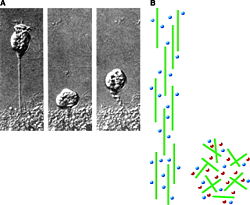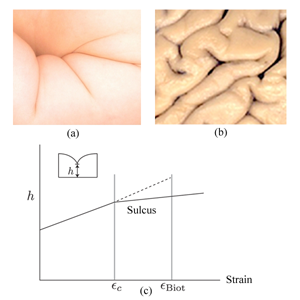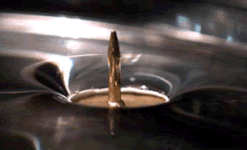Press
Our work, which often draws inspiration from the mundane, has been featured in various media, perhaps because it deals with the everyday world around us, which while familiar is not always understood ! A quote by the English lexicographer and man of letters, Samuel Johnson (1709-84) may be apt: “Vulgar and inactive minds confound familiarity with knowledge, and conceive themselves informed of the whole nature of things when they are shown their form or told their use.”
A recent article that visits many of these themes again is here and an older article that first visited these themes can be found here. Other articles include those by scientist and author Philip Ball on everyday science titled Foams of Fancy in Nature Materials, a Boston Globe editorial titled Why ? which was also reprinted as an editorial titled Let’s go on asking why in the International Herald Tribune, an article by mathematician Gilbert Strang of MIT titled A remarkable eye for out-of-the-ordinary mathematics published in the applied mathematics newsletter SIAM News, and an article in German by science journalist and author Giselle Weiss titled Das ratsel des zerknullten papiers for the Swiss newspaper NZZ.
Our work has also inspired artist Jonathon Nix ; paintings from an old exhibition include the Mahadevan Series.

You hear the musical saw. These mathematicians heard geometry. - May 2022
Link to Press ItemA scientist who has studied falling playing cards, coiling rope and other phenomena has now analyzed what transforms a carpenter’s tool into a sonorous instrument.
Related Publications

Fired from brushing his daughter’s hair, a scientist uses math to detangle the problem - May 2022
Link to Press ItemThe Harvard professor formed a team to solve a riddle stumping many exasperated parents: What’s the most painless way to brush tangled hair?
Related Publications

The physics of a singing saw - Apr 2022
Link to Press ItemInsights on centuries-old folk instrument is underpinned by a mathematical principle that may pave the way for high-quality resonators for sensing, electronics and more.

Tear-free brushing? All you need is math - Apr 2022
Link to Press ItemResearchers develop a mathematical understanding of detangling that could be used for textile manufacturing, robotic hairdressers

Shape-Shifting Materials With Infinite Possibilities: Totimorphic Structural Materials Can Achieve Any Shape - Oct 2021
Link to Press ItemResearchers from the Harvard John A. Paulson School of Engineering and Applied Sciences (SEAS) have developed a shape-shifting material that can take and hold any possible shape, paving the way for a new type of multifunctional material that could be used in a range of applications, from robotics and biotechnology to architecture.
Related Publications

Physicists get under the skin of apple growth - Oct 2021
Link to Press ItemResearchers in the US have used the physics of singularities to study the recess, or cusp, that forms around the stalk of an apple.
Related Publications

Constructing termite turrets without a blueprint - Feb 2021
Link to Press ItemResearchers develop a mathematical model to explain the complex architecture of termite mounds
Related Publications

Self-excited dancing droplets - Feb 2021
Link to Press ItemPlatform could be used for self-cleaning surfaces and other applications

A Scientist Who Delights in the Mundane - Oct 2020
Link to Press ItemFrom crumpled paper to termite mounds to three-sided coins, L. Mahadevan has turned the whole world into his laboratory.

Life from chaos - May 2020
Link to Press ItemResearchers use geometry and dynamics to better understand tissue organization.
Related Publications

A better understanding of soft artificial muscles - Nov 2019
Link to Press ItemResearch sheds light on the underlying mechanics of soft filaments
Related Publications

Shape-shifting of things to come - Sep 2019
Link to Press ItemComplex lattices that change in response to stimuli open a range of applications in electronics, robotics, medicin
Related Publications

Protein Clumping Best Blocked Using Specific Compounds at Distinct Disease Stages, Model Suggests - Aug 2019
Link to Press ItemA mathematical model created to more effectively prevent protein clumping, widely thought to underlie diseases like Parkinson’s, found that different potential treatments work best at different disease stages

How early-stage embryos maintain their size - Aug 2019
Link to Press ItemMechanical cues play critical role in shaping form and function
Related Publications
C.J. Chan, M. Costanzo, T. Ruiz-Herrero, G. Monke, R. Petrie, L. Mahadevan, T. Hiiragi, Nature 571, 112–116, 2019. [DOI] [View PDF] [Download PDF]

Cutting into shape - Aug 2019
Link to Press ItemMathematical framework turns any sheet of material into any shape using kirigami cuts
Related Publications

Using math to help treat Alzheimer’s, Parkinson’s and other diseases - Jul 2019
Link to Press ItemInsights into treatments for protein aggregation diseases from control theory and chemical kinetics
Related Publications
C. Weber, T.C. Michaels and L. Mahadevan, eLife 8:e42315, 2019. [DOI] [View PDF] [Download PDF]

Using origami memory to encode geometric information in floppy structures - Apr 2019
Link to Press ItemResearchers develop method to control the rigidity of structures through origami folds
Related Publications

How termite mounds get their shape - Feb 2019
Link to Press ItemShedding light on the principles of termite mound size and shape with a model coupling insect behavior and environmental remodeling
Related Media

Shaking the swarm - Sep 2018
Link to Press ItemResearchers explore how bees collaborate to stabilize swarm clusters
Related Media
Related Publications

A photosynthetic engine for artificial cells - May 2018
Link to Press ItemResearchers engineered a cell-like structure that harnesses photosynthesis to perform designer reactions
Related Publications

Mimicking birdsongs - Aug 2017
Link to Press ItemResearchers develop simple device to recreate complex birdsong
Related Media
Related Publications

Cracking the Mystery of the Egg Shape - Jun 2017
Link to Press ItemNot all eggs are shaped like a chicken’s—now we know why!
Related Publications

A stem’s ‘sense of self’ contributes to shape - Mar 2017
Link to Press ItemMathematical framework explains diverse plant stem forms
Related Media
Related Publications

Replicating folding of a fetal human brain - Feb 2016
Link to Press ItemThe distinctive troughs and crests of the human brain are actually not present in most animal brains; highly folded brains are seen only in a handful of species, including some primates, dolphins, elephants and pigs. In humans, folding begins in fetal brains around the 20th week of gestation and is completed only when the child is about a year and a half.
Related Media
Related Publications

Designing a pop-up future - Jan 2016
Link to Press ItemSimple origami fold may hold the key to designing pop-up furniture, medical devices and scientific tools
Related Publications

On Growth and Form: Geometry, Physics and Biology - Dec 2013
Link to Press ItemOf the diversity of living form, Charles Darwin said, “It is enough to drive the sanest man mad.” A century and a half later, how can we quantify, understand and predict this variety? How might we control it? Motivated by biological observations on scales ranging from molecular to histological, L. Mahadevan will explain how a combination of biological and physical experiments, together with mathematical models and computations, begin to unravel the physical basis for morphogenesis. He will go on to explore how these pan-disciplinary problems enrich the origins of this topic, creating new questions in mathematics, physics and biology.
Related Media
Related Publications

A cutting edge issue resolved - Dec 2012
Link to Press ItemPlanning to have roast turkey at Christmas? You’ll be glad to hear that physicists have revealed exactly how to carve it – using jelly and a fishing line.
Related Publications

Biological Springs and Ratchets - Aug 2012
Link to Press ItemBiological movements are brought about in various ways, and not all of these involve the action of motor proteins. Apart from motor proteins, biological movements can be brought about by components that act like springs and ratchets. Biological springs store potential energy in various protein filament conformations, while biological ratchets act by biasing random Brownian motion and turning it into directional polymerization.
Related Publications

How the lily blooms - Mar 2011
Link to Press ItemFrom a mismatch in growth, a flower blooms
Physicists reveal forces at work in the blossoming of a lily.
Related Publications

Unfolding the sulcus - Mar 2011
Link to Press ItemFolds on the surface of soft materials are shown to be a consequence of a nonlinear instability

Population dynamics of red blood cells - Jan 2011
Link to Press ItemHiggins and Mahadevan analyzed data on red cells and derived an equation model of red-cell maturation and clearance. They observed that the threshold for clearance is lowered with iron-deficiency anemia and thalassemia trait and showed how their model can differentiate these two disorders.
Related Publications

Shape of a long leaf - Nov 2009
Link to Press ItemCause behind the characteristic shape of a long leaf revealed
Related Publications

The ruck’s progress - Nov 2009
Link to Press ItemWhat the ruck?—The physics of a bump in a rug
Not one, but two papers that examine the physics of a bump in a rug have …
Related Publications

MacArthur Fellowship Announcement - Sep 2009
Link to Press ItemApplied Mathematician | Class of 2009
Investigating principles underlying the behavior of complex systems to address such accessible, but vexing, questions as how flags flutter, how skin wrinkles, how Venus flytraps snap closed.
Related Media

Botanical ratchets - Jul 2009
Link to Press ItemSeeds Are Nature’s Most Efficient Ratchet
Related Publications

Helical assemblies of bristles - Jan 2009
Link to Press ItemResearchers control the assembly of nanobristles into helical clusters
Related Publications

Crack patterns - Dec 2008
Link to Press ItemCracking the Giant’s Causeway: Solving a 300 year old geology problem using kitchen materials
Related Publications

Simple curiosities compel scientist - Oct 2008
L. Mahadevan smiled at the question, which was: “What, exactly, do you do?” It is, on the surface, a simple question, but for Mahadevan the answer could lead many places. Or, maybe, that’s the answer, that Mahadevan, a 43-year-old professor at Harvard, studies seemingly simple, everyday questions, “I am a wanderer, … and too curious about too many things, …. “
PDF
Mathematics and map folding/unfolding - Mar 2008
Link to Press ItemIf you’ve ever been lost, you’ve experienced the frustrations of folding up a map. L. Mahadevan, a professor of applied mathematics at Harvard University, has studied wrinkles and folds, and joins Noah Adams to talk about why it’s so difficult to get that roadmap back into your glove compartment.

The Physics of the Familiar - Mar 2008
Link to Press ItemHow paint dries, the way flags flutter, how Nature discovered origami, and other marvels of the physical world.
PDFRelated Media
The wrinkling in an elephant’s trunk and in billionth-of-a-meter nanotubes proceed from the same physical principles. The oscillations and flutters that agitate a piece of paper when you blow on it operate by mechanisms similar to those that caused an improperly designed bridge to tragically, and famously, collapse. Watch demonstrations by applied mathematician Lakshminarayanan Mahadevan, whose curiosity and analytical prowess combine to identify and then explain phenomena such as the vexing problem of folding up a map (to which nature has invented a brilliant solution).
Finding Physics in Everyday Objects from Harvard Magazine on Vimeo.

Flying carpets - Dec 2007
Link to Press ItemHere’s a seasonal news story I just wrote for Nature, which will appear (in edited form) in the last issue of the year. I gather, incidentally, that the original text of the ‘Arabian Nights’ doesn’t specify that the carpet flies as such, but only that anyone who sits on it is transported instantly to other lands.
PDF
Ignobel Prize Announcement - Aug 2007
Link to Press ItemA theoretical study of the way skin, apple peel, and bedsheets wrinkle won Mahadevan “a share” of this year’s Ig Nobel Prize in Physics. He “celebrated” this with a ditty and an essay-let:
The Ignobility of Wrinkles
Wrinkle, wrinkle on my skin
How, I wonder, did you begin ?
By sagging, and swelling and shrinking too
While stretching and bending were mixed into a brew
Till ahah, a formula that fits on a pin
How infinitely familiar and yet how far from being understood our immediate environment is! No one reminds us of this everyday more than children- and so I thank them all, and in particular, our own two, Kausalya and Aditya.
Wrinkle, wrinkle on my skin
Where, I wonder, did I sin ?
Celebrated in art and drapery
Until ahah, pruned by surgery
And then, just a has-been !
I am glad that this little piece of work has amused you, as it did us. I started looking at the problem of wrinkling a few years ago, noticing as you have, that these nuisances appear everywhere – indeed you too will see more of them as you grow older, so you had better get used to them! I had obtained a simple mathematical formula for the size of wrinkles in various situations, and on talking with my former postdoctoral fellow, Enrique Cerda, found that he had independently obtained some of the same results. So we wrote a paper that is one of those cited generalizing these ideas. Later, with others, I explained how wrinkles appear in nanotubes, elephant trunks, and even the lithosphere, the skin of our planet – of course then we call them mountains.
This little problem serves, I think, to teach us how infinitely familiar and yet how far from being understood, our immediate environment is. No one reminds us of this everyday more than children – and so I thank them all, young and old!
Curiosity is what underlies science which is now even part of our culture as this part parody, part revue that is the Ignobel proves! And like any other cultural activity, such as art and music, it can be and indeed it should be, unapologetically fun. It is fun to figure out how things work, at any and all levels, ignoring the artificial hierarchy on the supposed importance of the questions we ask – after all, Nature never imposes one! A quote by the English lexicographer and man of letters, Samuel Johnson (1709-84) may be apt: “Vulgar and inactive minds confound familiarity with knowledge, and conceive themselves informed of the whole nature of things when they are shown their form or told their use.”
May we long continue the tradition of celebrating da mental fun in the mundane!
L. Mahadevan
Related Media
Related Publications
Physicists make ripples with their “magic carpet” - Aug 2007
PDF
The “Cheerios” Effect - Dec 2005
Link to Press ItemCereal Science: Why Floating Objects Stick Together
Related Media
Related Publications
A. Chakrabarti, L. Ryan, M. K. Chaudhury and L. Mahadevan, Europhysics Letters , 112, 54001, 2015. [View PDF] [Download PDF]

Self organized Origami - Aug 2005
Origami May Be an Art, but Nature Got There First
Related Media
International Herald Tribune – “Let’s go on asking why ?” - May 2005
Link to Press Item
Flutter of a flag - Feb 2005
The flutter of a flag in a gentle breeze, or the flapping of a sail in a rough wind are commonplace and familiar observations of a rich class of problems involving the interaction of fluids and structures, of wide interest and importance in science and engineering. In a recent study, we studied the mechanism that leads to this instability using a combination of analysis and scaling that lead us to a relatively simple theory for the critical velocity for the onset of flutter and the frequency of flapping.

Image courtesy of M. Argentina
Related Media
- “What it takes to get in a flap”, The Guardian, 3 February 2005
- “Kármánsche Wirbelstraßen bringen Fahnen in Schwung”, Die Welt, 14 February 2005
Related Publications

Captured: how the flytrap snaps - Jan 2005
Link to Press ItemThe rapid closure of the carnivorous plant Venus flytrap (Dionaea muscipula) is one of the fastest motions (typically 100 ms) in the plant kingdom and led Darwin to describe the plant as “one of the most wonderful in the world.”
Related Media
- “Researchers explore mystery, and say gotcha”, Boston Globe, 27 January 2005
- “How a Venus flytrap snaps up its victims”, New Scientist, 29 January 2005
- “Sharing secrets of the Venus flytrap”, Harvard Gazette, 26 January 2005
- Venus flytrap plants use a built-in snap, MSNBC, 26 January 2005
- Venus Flytrap’s Speed Secret Revealed, Live Science, 26 January 2005
- Secret of the Venus Fly Trap Revealed, 27 January 2005
- Scientists discover secret of venus flytrap’s snap, ABC News Online, 27 January 2005
- Harvard scientists discover how the venus flytrap snaps, Eureka Alert, 26 January 2005
- How a Venus flytrap plant catches bugs, Scripps Howard News Service, 26 January 2005
- In a Snap: Leaf geometry drives Venus flytrap’s bite, Science News, 29 January 2005
- Why, Boston.com, 2 February 2005
- “What it takes to get in a flap”, The Guardian, 3 February 2005
- Let’s Keep Asking Why, The Boston Globe, 3 February 2005
- Venus Flytrap – Leader in Biometrics? Newswatch 50
- Plants teach big lessons about how to get going, 16 June 2005
Related Publications

Fashion gets physical - Mar 2004
Link to Press ItemNext time you are trapped inside a neon-lit changing room trying on a possible clothes purchase, you might think of calling a mathematician, rather than a sales assistant, to help work out why those trousers aren’t hanging just right. Researchers from Harvard University and the University of Santiago in Chile have begun to solve the equations governing the way in which fabric drapes, and hope that their work will help make shopping a little easier in the future.
Related Media
Related Publications
Biomimetic Ratchets – of snails and snakes - Dec 2003
Link to Press ItemResearchers from the University of Cambridge in England and Lehigh University have shown that it is possible to make a strip of hydrogel mimic the movements of a snail, inchworm, and snake.
Related Media
Related Publications

New Wrinkle On Fighting Crow’s Feet - Mar 2003
Link to Press ItemRelated Media
- Physik des Faltenwurfs. Altbekannter Lebensretter, Die Zeit, 27 February 2003
- New Wrinkle On Fighting Crow’s Feet, Physical Review, 21 February 2003
Related Publications
Aphids Marbles - Jul 2002
Insects provide examples of many cunning stratagems to cope with the challenges of living in a world dominated by surface forces. Despite being the current masters of the land environment, they are at constant risk of being entrapped in liquids, which they prevent by having waxy and hairy surfaces. The problem is particularly acute in an enclosed space, such as a plant gall. Using secreted wax to efficiently parcel and transport their own excrement, aphids were able to solve this problem 200 Myr ago. Here, we report on the physical and physiological significance of this ingenious solution. The secreted powdery wax has three distinct roles: (i) it is hydrophobic, (ii) it creates a microscopically rough inner gall surface made of weakly compacted wax needles making the gall ultra-hydrophobic, and (iii) it coats the honeydew droplets converting them into liquid marbles, that can be rapidly and efficiently moved.
Related Media

Collapsing Bubbles - Feb 2000
Link to Press ItemWhen a bubble of air rises to the top of a highly viscous liquid, it forms a dome-shaped protuberance on the free surface. Unlike a soap bubble, it bursts so slowly as to collapse under its own weight simultaneously, and folds into a wavy structure. This rippling effect occurs for both elastic and viscous sheets, and a theory for its onset is formulated. The growth of the corrugation is governed by the competition between gravitational and bending (shearing) forces and is exhibited for a range of densities, stiffnesses (viscosities), and sizes—a result that arises less from dynamics than from geometry, suggesting a wide validity. A quantitative expression for the number of ripples is presented, together with experimental results that support the theoretical predictions.
Related Publications
A. Slim, J. Teichman, L. Mahadevan, Journal of Fluid Mechanics, 1-24, 2011. [View PDF] [Download PDF]

Crumpling - Sep 1999
Link to Press ItemWhat do mountains, wrinkled slacks and a crushed soda can have in common? The answer: all have been crumpled
Related Publications

Tumbling Cards - Dec 1998
Link to Press ItemWhen a stiff rectangular card is dropped in still air with its long axis horizontal, it often settles into a regular mode of motion; while revolving around its long axis it descends along a path that is inclined to the vertical at a nearly constant angle. We show experimentally that the tumbling frequency ΩΩ of a card of length l,l, width w and thickness d (l≫w≫d)(l≫w≫d) scales as Ω∼d1/2w−1,Ω∼d1/2w−1, consistent with a simple dimensional argument that balances the drag against gravity.
Related Publications

Fluid Rope Tricks - Mar 1998
Link to Press ItemRelated Media
Physicists Study the Honeybee For Clues to Complex Problems



 Prof. L. Mahadevan
Prof. L. Mahadevan